Special Supplement: School CIO Summit: Edtech Leaders Create Their Dream Districts

The theme for the Denver 2013 School CIO Summit was on facilitating change. This event offered innovative school leaders the opportunity to exchange conversations about how they have become change agents in their districts, including how they overcame challenges or manage existing challenges. This conversation culminated in an activity facilitated by School CIO Advisors Henry Thiele and Carl Hooker, who challenged the group to put their ideas into action through an activity that allowed them to create their dream school district.
Special thanks to our event sponsors Amplify Access, Amplify Learning, Google in Education, HP, Intel, Lightspeed Systems, and Gaggle.
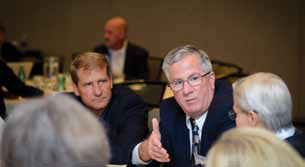
UTOPIAN USD
School CIO Summit: Denver 2013
At the Denver SchoolCIO Summit in September, Tech & Learning advisors Carl Hooker and Henry Thiele posed a unique challenge to the attendees: building a dream school despite myriad challenges. Here was the setup:
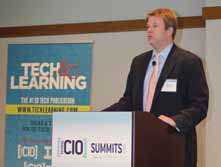
CONGRATULATIONS! The year is 2018 and YOU are the winners of a prestigious award for being a part of the greatest district transformation ever. You are looking back on the last five years and realize it all started that fateful day back in September of 2013. Immediately following the Denver School CIO Summit, you were recruited (because of the innovative thinking you shared at that summit) to be a part of Utopia USD. Utopia is a medium-sized district with quite the digital divide and budget issues. When you came in, they lacked visionary leadership and had a very unsupportive community when it came to social media and ubiquitous technology. The press didn’t help. In the spring of 2013, a teacher tweeted out a comment about the lack of direction in Utopia USD and was fired, which the press took and ran with. There were also widespread rumors and fears about inappropriate social media communications between teachers and students, cyberbullying, and older technology sitting unused in closets.
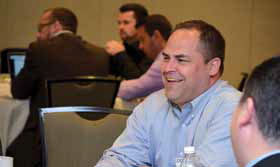
Tech & Learning Program Director Judy Salpeter introduces the morning panelists.
Tools and ideas to transform education. Sign up below.

Shortly before you were hired, the board of education developed a new strategic plan that provided the challenge to prepare all members of the Utopia learning community with 21st-century skills that would transform teaching and learning in the classroom and would prepare students to build on those skills throughout their lives. What did you and your team do in your particular area of expertise to achieve so much in those five years and to transform Utopia USD into the magical district that it has become?
Each participant was assigned to a table, and each table had a specific task. Here’s how they responded to the challenge.
1. Budget, sustainability, and communication with parents and community
To put in place strategies and policies that ensured continued funding for success, the Utopian USD leadership team convened a team of board members, business partners, site faculties, and the voting constituency to work on the plan. This team conducted a survey of school board members, parents, teachers, and students to assess the community’s goals for the district. This survey helped define best practices for existing tools, as well as the identifying key new technologies and techniques that could help support these specific goals.
Above: Carl Hooker and Henry Thiele lead the group discussion; Below left: Jean Tower, Director of Technology of the Public Schools of Northborough & Southborough in MA.; Below right: David Rose, Director Educational Technology & Library Media Services, District of Columbia Public Schools, DC
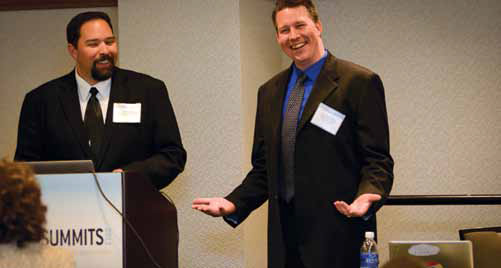

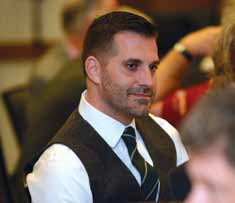
After gathering this data, every department head generated and completed an inventory of what they were currently managing and a chart of the expected refresh rates for those assets. From there, the leadership team fine-tuned a clear vision and developed a plan to get the district from where they were to where they wanted to be.
The key components to this plan included:
* Use scalable language like “classroom technology “ rather than “laptops.”
* Ensure sustainability by evaluating longterm costs of leasing versus buying. Make sure the agreement is a true lease and not a lease to buy. Lease the hardware and the curriculum.
* Be creative with the budget. Use general funds for the strategy to avoid grant fund sorrows. Use the food program to generate profits to build up the general fund for the strategy.
* Write tech levies that specify what the district can do with the funds and sell the “why” through best practice stories. Build a model to sell your story. Use finite funds to build a model classroom project that inspires positive press. Use this model and publicity to secure community support via levies.
* Work with your vendors. Ask legacy vendors to re-evaluate leasing fees to free up funds for new purchases.
* Keep writing grants. Despite the finite nature of grants, keep writing them for projects like solar energy, which can also result in tax rebates.
The leadership team shared the resulting success stories at town hall meetings, focus groups, PTO meetings, and sub-council meetings where sponsored guest speakers presented specific topics. They posted Twitter feeds from board meetings to gather community input, discuss plans, and share ideas. The board meetings rotated between each school site and used various social media tools to encourage remote collaboration in real time. All of this information was also shared with the entire community through e-mail reports and on the school Web site, including short videos designed to further engage the parent and school community.
Because the board of education, administration, and community were engaged in the development of a clear vision and making a specific plan to turn that vision to action, they had the ownership required to support the plan.
2. Infrastructure and technology resources
The Utopian USD leadership team started with two main premises:
* Infrastructure is a utility—it’s like electricity. It just works; you don’t question it.
* Infrastructure is also ubiquitous—it flows with the device and is not limited to a facility
The discussion gets lively as attendees compare notes from their work groups.
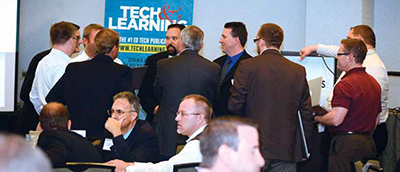
The kinds of devices these attendees wanted to see in this school were all “intelligent structures.” In this school, everything becomes technology, such as walls, surfaces, and wearable technology. All data analysis is automated.
The technology and infrastructure required the following characteristics:
* Must be robust, scalable, high speed, reliable, always on, and flexible.
* Must have a fiber backbone and have both a wired and wireless network.
* Must be secure and include a firewall, intrusion detection, and prevention.
* Most of the infrastructure should be in the cloud.
* All programs must be interoperable and device agnostic.
* Minimal print services will be needed.
* School facilities are flexible workspaces to support new ways of learning.
* Other devices include 3D printing, school robotics, wearable technology (featuring location embedded chips), telepresence robots, gamification, exercise facilities, and immersive virtual worlds.
The technology at Utopia USD would be used for learning, collaboration, and efficiency.
Everyone at the school will use these cloud-based resources—not just student or teachers. The environment will offer ubiquitous computing. The technology is always on, regardless of the users’ location or type of device.
3. Teaching and learning
The Utopian USD team recreated the learning spaces in all schools. They tore out walls, eliminated traditional “classrooms” and put in flexible furniture that is movable, multi-use, modular, and wheeled. They eliminated bells and seat time, and gave students a flexible schedule that requires them to be present when they need to be. Here how this change affected different communities at the school:
Greater Clark Schools (IN)’s Director of Technology Brett Clark reports on the highlights from his work group.
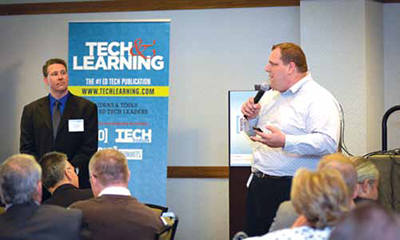
Students: The idea labs and common areas are all task-specific spaces—students flow in and out to craft things with a resource (i.e., an available teacher or an expert). The focus is on competency-based learning. Students are connected to a team or they may have multiple teams going with multiple projects. Students may meet with 20-25 adults in the course of a project and tap into community experts. Their student-led schedules will be fluid to meet those needs. These schedules could include an unscheduled lunch, meeting in common areas for lunch, asking teachers for on-demand answers, and completely redefining the definition of dual enrollment. Students may matriculate when they have shown they are ready. Their grade structure has been reconsidered and their personalized learning and student portfolio travels with them until graduation.
Teachers: Teachers guide groups of students as necessary. The teacher day is also non-structured and projects are not based on a time model. Instead, the teacher focuses on the outcomes of the group. Teachers have a caseload or advisory team that includes multiple instructional leaders. Professional mentors are brought in to join an integrated advisory class built on service learning and career experience. Mentors are assigned to students to provide personalized support designed to create a broader path for students to prepare for life after high school, whether that path be college or a career. Technology is used to reduce record keeping and assessment tasks for teachers so they can spend more time on higher-order thinking skills.
4. Professional learning and staff communication
At Utopian USD, the administration recognizes that adults learn and grow just like students do, so they apply the following pedagogy to their PD:
* Learning doesn’t start and end with the school bells—for teachers or for kids
* Apply a differentiated approach
* Encourage the teachers to value the learning more than the hours
* Encourage all of the “adults”—not just teachers, but all staff—to collaborate with each other, as well as with parents, students, and other school community members. This collaboration is encouraged through using social media, personalized modules, face-to-face opportunities, webinars, and bringing in experts to teach students, such as doctors and college professors.
Left: Sheryl Abshire, Chief Technology Officer, Calcasieu Parish Public Schools, LA; Right: Lydia Dobyns, President of the New Tech Network based in Napa, CA.
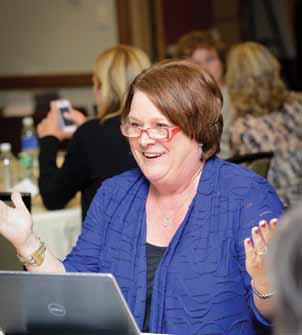

PD learning is 24/7 to allow for self-paced, flexible opportunities to match any schedule. PD events include PD in your PJs, job-embedded coaching, and lunch and learn programs—all of which are structured to support a variety of learning models.
5. Standards and assessment
The team at Utopian USD assesses Common Core standards and Next Gen science standards (with a heavy dose of the 4 C’s) using the following accountability methods:
* They assess their students by using problem- or project-based learning portfolios. They use many types of assessments, recognizing one test does not fit all students.
* They use a dashboard for district-level administrators that provides principals with the data feedback needed to provide professional development as needed.
* They use a bank of common formative assessments that are graded and scored by teachers to inform best practice.
* They use Universal Design for Learning to meet the multiple needs of students. * Teachers and students work together on assessment and data analysis process, including dialogues about IEPs.
* There are no grade levels. They have shifted to a “Center for Learning” environment that advances students based on mastery of skills.
The infrastructure committee discussed what the ideal facility bones would include.
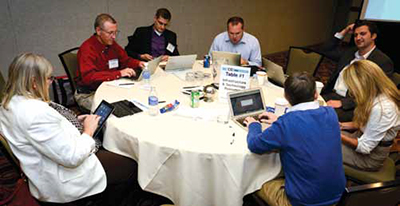
While the Utopia USD experiment focused on a fictional district in the not-so distant future, the reality of it is not that far fetched. Communication between all areas and groups is paramount. Flexibility was a term that came up in almost all groups. From funding to furniture, devices to student schedules, having buildings that were adaptable to change and differentiated learning styles was of upmost importance. In the end, we put to our readers: Which is Utopia USD? A futuristic, fictional dream scenario or a reality that can happen in the near future?
“What’s the ultimate expression of human knowledge? Writing. It’s our greatest strength as a species and the ultimate expression of being educated. Our Inspired Writing program emphasizes authentic writing experiences, professional development for teachers, and a 1:1 program in English language arts. We focus on developing the most effective and powerful writers we can among our learners. Currently, our students produce 20,000 Google docs a month. They blog, write in Word, and 300 2nd-grade students recently completed a Google Docs pen pal project in which they collaborated two to three times a day. After implementing this program, we saw at 14% gain in student achievement.”

—Dan Maas, Chief Information Officer, Littleton (CO) Public Schools
“This year many of our textbooks have an online component. The infrastructure has been updated for BYOD and a possible 1:1 program. We have purchased 400 iPads for the district according to subject area, such as 30 for language arts, 30 for social studies, and 30 for science. We also purchased 700 Chromebooks for preparation for the Common Core and PARRC. Due to a Hurricane Sandy grant, the district received an additional $769,000 for preparation of the PARCC assessments, including the infrastructure for 100,000 per student. With this requirement, Sayreville will need 650 MB of Internet access. At present the district only has 100MB for Internet access. We are upgrading our firewall and upgrading to 1 GB of Internet access. [We] will also purchase an additional 1,800 Chromebooks for the district, hopefully by December 2013. Sayreville will be participating in the field testing of the PARCC assessment in March and May 2014. Currently, we offer online courses in AP Physics, AP Statistics, AP Psychology, AP Micro/Macro Economics, AP Calculus, and Managerial Accounting for our high school students. We are looking into e-textbooks in the coming school year. The district uses Nooks for Internet access and as e-readers. Many of our language arts teachers use books that are in the curriculum on the district Nooks.”

—Sandra Paul, Director of Technology, Sayreville (NJ) Public Schools
“Five years ago, we began a teacher training program that requires every teacher to attend a three-hour technology workshop each summer. This was fully supported by our board. I work with the technology director and the curriculum department to develop the curriculum for this training. We have a district wiki for our curriculum to which teachers contribute. It holds all supplemental material as well. Two years ago we completely revamped our take on the elementary computer lab class. I have written the curriculum for all K-6 students. Topics now include Famous People in Computers (taught in grades K-4), Introduction to Word Processing (grades 2-3), Image Manipulation (grades 2-6), introduction to spreadsheets (grades 2-3), Introduction to Gmail (grade 3), Binary, Google Drive and Sites, and Formulas in Spreadsheets (grades 5-6). We began offering classes not just for parents but for the community to show them what we are doing. [W]e help them set up their own Google accounts and teach them how to use them.”

—BJ Brooks, director of instructional technology, Cabot (AR) School District
Old school service = standardized content. We were bound by time from 8am to 4pm, 180 days a year. New educational motto: Just like you like it. Why not offer a buffet? Learn what you want. Let the students drive their learning. Every taste is different and must be tailored for learning.
—Carl Hooker, Director of Instructional Technology and iPadpalooza Founder, Eanes (TX) ISD
Logistics Working Group Highlights
The partnership between technology and curriculum really depends on the successful relationship between the leaders of these departments.

—Jean Tower, Public Schools of Northborough and Southborough, MA
As it relates to professional development, we have removed all required hours from our teacher contract and built professional development into the supervision process. PD is differentiated to meet the needs of staff. Principals help staff develop their own roadmap for success at the beginning of the school year. Some PD is now online in synchronous sessions, others through video tutorials, and still others in a face-to-face environment. Much of our PD is teacher led and designed to meet the request of teachers.

—Tom Murray, Director of Technology and Cyber Education, Quakertown Community School District, Bucks County, PA
I am trying many different strategies to ensure that our teachers in the high school embrace our 1:1 iPad rollout. We named the initiative “Mobile Minds” to divert the attention from the technology and on to the power of the collaboration and transformation.

—Julie Bohnenkamp, Director of Technology, Center Grove Community School Corporation in suburban Indianapolis
Our challenge is organizing technology training sessions so that 100% of the attendees regard them as meaningful (and a priority over the other tasks on their to-do lists).

—Elizabeth Janowiak, Director of Technology Geneva CUSD 304, Geneva IL
Technology is not only physically housed with teaching and learning services, we are required to attend all teaching, learning, and curriculum functions. However, we don’t report to the head of teaching and learning, we report directly to the superintendent. Our budgets are also uniquely intertwined, making sure that technology isn’t making educational decisions and teaching/ learning can’t proceed with major technology expenses without technology involvement.

—Brian Abeling, Director of Technology, West Des Moines Schools, West Des Moines, IA
“We have 6,000 students and a strong leadership team that counts on principals as education leaders. There are no instructional technology specialists in our schools; we rely on our teachers to fulfill that role.”
—Grace Magley, Supervisor of Online Learning, Natick (MA) Public Schools
Lessons from a Mobile Learning Initiative
When Orleans Parish Schools, LA, launched their “Learning on the Go” program, Peggy Villars Abadie said they learned that the most important variable to their success was lots of teacher PD in preparation for the project. This training should include:
• How to handle a down/unavailable device.
• How to design classroom use of the devices in learning.
• How to manage a 1:1 classroom.
• How to engage learners and access the power of personal learning devices.
Abadie also cites technical support of the devices as being crucial. On average, the district allotted at least three hours daily to handle technical concerns.
Three change leadership practices
1. Shine the light. Bring focus and energy to the problems you want to solve. Spread the word to parents and community. Tell a compelling story. Paint a picture that’s desirable. Make one-click shopping (a la Amazon) in schools.
2. Loose/Tight leadership. Create a core set of principles everyone agrees on. People within that framework can make leaps of creativity that make change happen. We’re not looking for droids. Think for yourself and find the way to bring core principles to life.
3. Build relationships. Without strong relationships, no one will move ahead and [change] won’t happen. Build a climate where people are not afraid to take risks. Create a platform for teachers’ voices, one bite at a time.
—Jean Tower, Director of Technology, Public Schools of Northborough and Southborough, MA
Preparing Students To Be Successful for Life
The world does not behave like a traditional classroom. Learning is a choice; technology amplifies potential. It’s about more than buy in; it’s about ownership. We achieve [success] by being partners. We can’t leave this to chance. Have a clear plan. What change can you make in 100 days?

—Ben Grey, Chief Innovation Officer and Art Fessler, Superintendent, Community Consolidated School District 59, IL
“Norman Public Schools is a PreK-12 district of just over 15,500 students. The district has implemented an Intelligent Classroom Project in approximately 1,100 classrooms. Each classroom is equipped with an interactive whiteboard, a document camera, projector, three wireless slates, student response systems, sound solution, cart for all equipment, a wireless laptop and docking station. Time and time again we are seeing student engagement as a huge benefit of the Intelligent Classroom. Both elementary and secondary teachers have reported that the Intelligent Classroom technology allows them to teach students in a more interactive and engaging way. An elementary teacher eloquently shared her thoughts which we hear over and over from many teachers: ‘Children need a variety of experiences and modalities to gain mastery of basic skills and fuel their passion for self-regulated learning which will lead them into productive citizenship, college, and careers. They love using the Mobis (wireless slates) for interactive games. Clickers provide feedback and data in a concise, timely manner.’ This installation has included three years of intense professional development for all teachers based on the ISTE NETS standards. At this point in the project we are transitioning the PD to a team of teachers at each school site. This will provide a sustainable model of professional development as we move forward.

—Kathryn Lewis, Director of Media Services and Instructional Technology, Norman (OK) Public Schools
